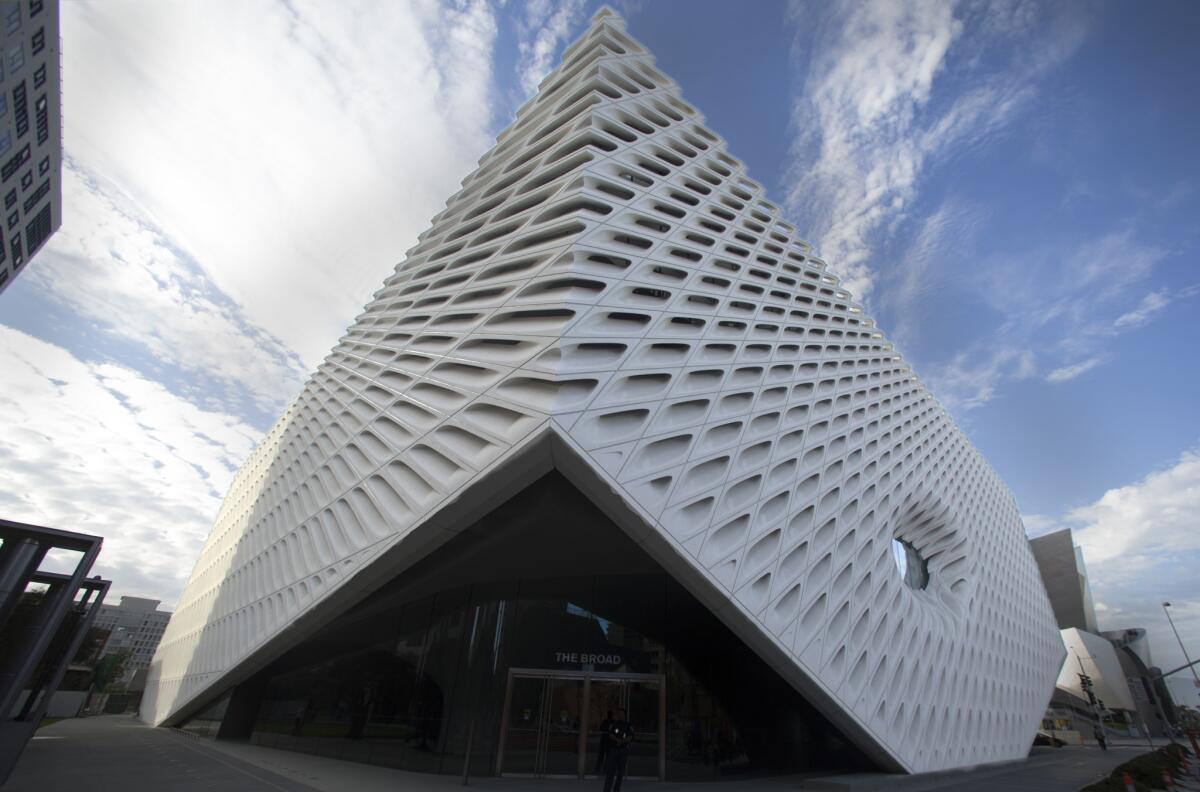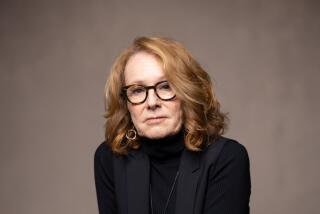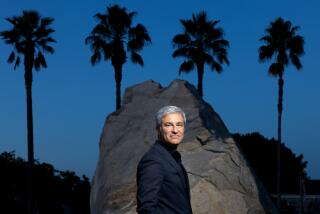Eli Broad, white knight and lightning rod, gets ready to open his own museum

The Broad contemporary art museum in downtown Los Angeles, scheduled to open Sept. 20, 2015.
- Share via
The opening of the Broad museum on Sept. 20 will complete a 36-year bank shot in which founder Eli Broad bounced from one major L.A. art museum to another, with controversy at every stop, before concluding that the collection of contemporary art he has amassed with his wife, Edythe, should have a home of its own.
Broad’s campaign to build his museum dates back about seven years. Since then he has spent or pledged at least $340 million to make it a reality, tapping a $6-billion fortune amassed from building homes and selling retirement investment plans.
The 120,000-square-foot museum on Grand Avenue in downtown Los Angeles offers free admission — a benefit made possible because Broad, 82, has promised to add an endowment of at least $200 million to the $140 million paid for construction. There may be future charges for special exhibitions, but admission to the permanent collection galleries will remain free.
The Broad’s first flock of visitors in coming months will see more than 250 highlights, including works by Andy Warhol, Jeff Koons, Jean-Michel Basquiat, Jasper Johns, Cindy Sherman, Takashi Murakami and scores of other art world luminaries from the 1950s to today. The collection of about 2,000 works has cost the Broads untold additional millions.
The building has 50,000 square feet of galleries and a modest area for its business offices and a 200-capacity events and lectures space. It also enfolds a huge “vault” that will store the art that’s not on display. Visitors ascending and descending by stairs or an elevator can get a glimpse inside through a picture window.
Broad’s museum may be new, but he is hardly new to the intricacies of launching museums. He helped found L.A.’s Museum of Contemporary Art starting in 1979, then left its board amid bruised feelings a few years later. In 1984 the Broads started the Broad Art Foundation as a vehicle to regularly lend pieces from their collection to museums around the world that want to show them — a service that will continue largely unchanged after the Broad opens.
In the mid-1990s, Broad turned his attention to the Hammer Museum in Westwood. Oil magnate Armand Hammer died shortly after it opened in December 1990 and had failed to provide an ample endowment or a coherent management structure. Broad helped UCLA officials get the museum on a secure footing, but that included the hotly criticized move, partly orchestrated by Broad, of selling off the museum’s prized illustrated manuscript by Leonardo Da Vinci. Bill Gates bought it for $30.8 million, giving the Hammer the financial backstop it had lacked.
In the early and mid-2000s Broad focused on the Los Angeles County Museum of Art, donating millions to promote a county ballot measure that would have provided $100 million in public funds for an ambitious new design by architecht Rem Koolhaas. When it narrowly failed to pass, Broad bankrolled the fallback plan, picking Renzo Piano to design the Broad Contemporary Art Museum. BCAM opened in February 2008 with 160 selections from the Broads’ collection. It drew 26,000 visitors in its first three days.
But shortly before BCAM and its 60,000 square feet of galleries opened, Broad had let it slip that he was only loaning his art to LACMA and would not be donating his holdings to any museum. It was widely interpreted as a slap at LACMA and its director, Michael Govan. Some public bickering ensued a few years later over whether Broad had fulfilled his pledge to cover all construction costs, which LACMA contended totaled $55.5 million rather than the $50 million Broad had given.
Broad’s last deep involvement with an established Los Angeles museum was his December 2008 rescue of MOCA, which needed his $30-million, five-year bailout pledge to stave off bankruptcy after years of overspending had left it unable to withstand the global financial meltdown.
But that white-knight move turned divisive when, at Broad’s behest, MOCA hired Jeffrey Deitch, a prominent New York City art dealer, as its director. Deitch’s troubled three-year tenure tore fissures through MOCA’s board and delayed measures that more recently have put MOCA on a steadier fiscal and managerial footing.
Broad confessed in his 2012 book, “The Art of Being Unreasonable,” that he is too impatient to get along well on museum boards. “Unfortunately, the boards of art institutions tend to be populated with well-meaning supporters of the arts who often lack any business background or appetite for imposing appropriate discipline,” he wrote.
His drive to launch his museum began soon after the economy had tanked late in 2008. In October 2008, an attorney representing Broad sent a letter to the city manager of Beverly Hills, saying the billionaire philanthropist wanted to “confirm” his foundation’s “continuing interest” in building an art museum in the city.
Soon Beverly Hills officials were mulling plans for a 120,640-square-foot museum, about a third of it for public galleries. It would be shaped like a battleship so it could be wedged into a narrow strip of land Broad asked the city to provide.
Then Santa Monica officials came courting, asking Broad to build his museum on prime city-owned acreage a block from the beach. The president of West L.A. City College sent Broad a letter offering a parcel on its campus in Culver City. Broad kept that in his pocket as negotiations continued with Santa Monica and Beverly Hills.
Meanwhile, the Grand Avenue Project, a $3-billion plan to turn three blocks of government-owned parking lots in downtown Los Angeles into housing, shops and a hotel, had been thwarted by the economic crisis, which left the developer, Related Cos., unable to get financing to start construction.
By Broad’s account, then-Los Angeles Mayor Antonio Villaraigosa approached him late in 2009 about building his museum on one of the project’s parcels, south of Walt Disney Concert Hall. By May 2010, Broad had put Santa Monica and Beverly Hills on hold and was pushing to build downtown.
Besides realizing his museum dream, this option served another longtime item on Broad’s civic agenda — turning downtown L.A. into a hub of urban vitality. He also has made repeated offers to buy the Los Angeles Times.
“From the start, what we wanted was to make great contemporary art available to as many people as possible, and downtown L.A. was the best place to do that,” Broad said in his book.
L.A. officialdom agreed, almost without dissent, and by late August 2010 Broad had gotten the green light from four government boards whose OK he needed. The only testy moment came when Los Angeles County Supervisor Michael Antonovich insisted that Broad pay fair market value for a 99-year lease on the site instead of the $1 token payment Broad had expected in light of similar deals L.A. has with cultural organizations such as MOCA and the Autry National Center of the American West.
“It just burns me that people are saying they’re giving me, a billionaire, [a lease] for nothing, without looking at the public benefit being created. Getting criticized for that blows my imagination, frankly,” Broad told The Times.
Broad swallowed his irritation and agreed to pay $7.7 million for the lease. Officially characterized as a grant, the money subsidized affordable-housing units at the Emerson, a high-rise residential tower Related built next to the museum.
The fine print of the Broad museum’s deals with public agencies also includes an $8.5-million government share of the cost of the museum’s outdoor plaza and government payments of up to $30 million to reimburse Broad for building the museum’s underground parking garage. Under that buy-back provision, the garage eventually will be government-owned.
Additionally, the Broad will receive a 30% share of arts fees generated by the Grand Avenue Project as it gradually is built. Under city law, developers pay a 1% surcharge on their construction costs to provide public artworks or arts programs. The project was once estimated at $3 billion, which would mean about $9 million in arts fees for the Broad.
As usual with things Broad-related there’s a bit of controversy percolating as his museum opens — lawsuits between the Broad and contractors involved in fabricating and installing its honeycombed façade. The Broad alleged last year that Seele Inc. initially mishandled the work, delaying the museum’s opening by 15 months and hiking its cost by at least $19.8 million. Seele denied any blame and stayed on the job, countersuing for $10 million or more. The parties agreed to put their beef on hold until the building was finished.
To Selma Holo, director of USC’s Fisher Museum of Art, Broad’s roller-coaster ride through every major L.A. museum that features contemporary art has been fascinating and ultimately beneficial.
Despite all the controversies, she said, Broad has been “always moving us as a cultural community toward a larger and more complex conversation.” She sees it as a net gain for L.A.’s art scene that he built the Broad instead of handing off his collection to one or more of the three other museums he’d alternately supported and roiled.
“Not all the art in town has to be channeled” to existing museums, Holo said. The Broad will have a useful “different take” on how art is displayed and interpreted, she said. “As a grown-up city, I say the more the merrier.”
Ideally, said Hugh Davies, longtime director of the Museum of Contemporary Art, San Diego, wealthy art lovers such as the Broads would forgo spending huge sums on their own art showplaces and funnel their art and money to the collections and endowments of established museums.
“But it’s their money, their art and their choice,” Davies conceded, noting a long tradition of business magnates starting their own museums that in L.A. alone includes the Hammer, the J. Paul Getty Museum and the Norton Simon Museum.
“At the end of the day Los Angeles is much culturally richer as a result of Edye and Eli Broad,” Davies said. “He has jousted with many of my colleagues and has been mercurial, but the building he’s created is quite spectacular. At the end of the day he’s a generous and great man. I’m grateful I wasn’t a museum director who had to serve Eli, but I salute him from a safe, 100-mile-away perspective in San Diego.”
Now, after 36 mercurial years, Broad has landed his cultural bank shot in the pocket for which it was perhaps destined from the start — the one where the shot was his alone to call.
Twitter: @boehmm
More to Read
The biggest entertainment stories
Get our big stories about Hollywood, film, television, music, arts, culture and more right in your inbox as soon as they publish.
You may occasionally receive promotional content from the Los Angeles Times.











